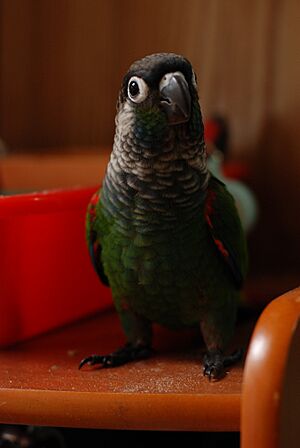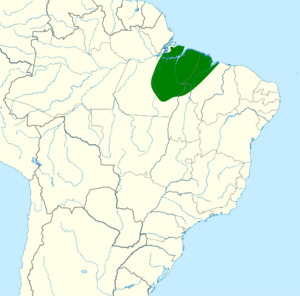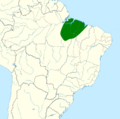Pearly parakeet facts for kids
Quick facts for kids Pearly parakeet |
|
|---|---|
 |
|
| Conservation status | |
| Scientific classification | |
 |
The pearly parakeet (Pyrrhura lepida) is a beautiful bird. Some people also call it the pearly conure. It is a type of parrot found only in Brazil. This bird is currently listed as a Vulnerable species. This means it faces a high risk of becoming extinct in the wild.
Contents
About the Pearly Parakeet's Name
The scientific name of the pearly parakeet has changed over time. It used to be called Pyrrhura perlata. But scientists found out that the original bird used to name P. perlata was actually a young crimson-bellied parakeet. Because of this, the pearly parakeet got a new official name: Pyrrhura lepida.
Different Types of Pearly Parakeets
There are three main types, or subspecies, of the pearly parakeet. These are P. l. lepida, P. l. anerythra, and P. l. coerulescens. Scientists are still studying these groups. They want to see if some of them should be considered completely separate species.
What Pearly Parakeets Look Like
Pearly parakeets are about 24 to 25 cm (9.4 to 9.8 in) long. They weigh between 70 and 80 g (2.5 and 2.8 oz). Male and female pearly parakeets look very similar.
Colors and Markings
Adult pearly parakeets have a dark brown top of the head. Their ear feathers are a light tan color. The rest of their face is a dull blue-green. They have whitish skin around their eyes. Their back feathers are green with a hint of blue.
Their upper chest and neck sides are brown with a scaly look. The chest also has a blue tint. The rest of their belly is green with a blue wash. Their wings are mostly green. The main flight feathers are black and bright blue. The feathers under their wings are red. Their tail is reddish-brown on top and dark brown underneath. They have dark brown eyes, a brownish-black beak, and dark gray legs. Young pearly parakeets look much like the adults.
Subspecies Differences
The P. l. coerulescens subspecies has a lighter head than the main type. Its throat and upper chest are grayer. It also has a stronger blue color on its lower chest. The P. l. anerythra subspecies has a red tint on its chest and belly instead of blue. It also does not have red on its wings.
Where Pearly Parakeets Live
Pearly parakeets live only in the north-central part of Brazil.
Specific Locations
The main subspecies, P. l. lepida, is found in northeastern Pará and northwestern Maranhão states. The P. l. coerulescens subspecies lives in eastern Pará, between the Xingu River and Tocantins River. The P. l. anerythra subspecies is found in central and northeastern Maranhão. Some have also been seen in Mato Grosso.
Their Home Environment
These parakeets live in humid forests. They can be found inside the forest or along its edges. They also live in secondary forest (forest that has grown back after being cut down). Sometimes, they are seen in open areas near the forest.
Pearly Parakeet Behavior
Movements
Scientists are not sure if pearly parakeets move around much. Their travel patterns are still unknown.
Feeding Habits
Pearly parakeets are known to eat fruits. However, not much else is known about their exact diet.
Reproduction
Unfortunately, very little is known about how pearly parakeets breed or raise their young.
Vocalization
The calls of the pearly parakeet sound a bit rough. They often make quick series of sounds like "krree krree krree" or "krek krek krek". They make these calls both when sitting on a branch and when flying. However, when they are perched, they are often quiet. When a group of parakeets flies together, they call often and at the same time. This creates a loud, harsh, and piercing chattering sound.
Conservation Status
The IUCN (International Union for Conservation of Nature) has changed the pearly parakeet's status several times. It is currently listed as Vulnerable. This means it is at high risk of extinction.
Threats to Survival
The pearly parakeet lives in a small area. Scientists do not know exactly how many of these birds are left, but they believe the number is going down. The biggest danger to the pearly parakeet is the loss of its home. Large parts of the lowland forests where they live have been changed or completely cleared away. Even some protected areas suffer from illegal logging, which means trees are cut down illegally.
Images for kids




